-
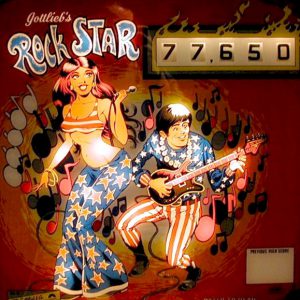 The game before you is extremely rare with only 278 screwed together at the Chicago Gottlieb factory. This one-player electromechanical add-a-ball game was designed by John Osbourne with art by Gordon Morison. A replay version was also designed by the name of Blue Note. The object of this machine is to complete all the notes down the left side of the playfield. Doing so activates the classic “wow” feature which, when hit, awards one free ball. A reset is in your future once your current ball drains. Score is another way to achieve longer play by winning extra balls. The spinner in the middle of the playfield awards big points when 1,000 points is lit; each spin of the target awards 1,000 points plus number of revolutions spun. A nice retro art package completes this rare machine.
The game before you is extremely rare with only 278 screwed together at the Chicago Gottlieb factory. This one-player electromechanical add-a-ball game was designed by John Osbourne with art by Gordon Morison. A replay version was also designed by the name of Blue Note. The object of this machine is to complete all the notes down the left side of the playfield. Doing so activates the classic “wow” feature which, when hit, awards one free ball. A reset is in your future once your current ball drains. Score is another way to achieve longer play by winning extra balls. The spinner in the middle of the playfield awards big points when 1,000 points is lit; each spin of the target awards 1,000 points plus number of revolutions spun. A nice retro art package completes this rare machine. -
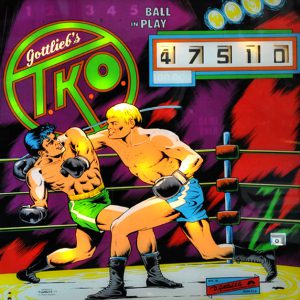 Look no further! If you’re searching for the rarest of the rare, here for your perusal is not one but two examples of this Gottlieb aberration. Supposedly only 125 were made of this game and most were sold overseas. Ed Krynski and Gordon Morison again teamed up to art and design the game. This game represents one of the last electromechanical “wedgehead” games ever built near the shores of Lake Michigan. It’s also a single-player game and one of the last. The object of the game is not really boxing in the true sense but hitting enough targets to advance the central advance display up to the top of the rack. This will ignite the special lights for a free game. The color-coordinated advance inserts on the play field correspond to the light-up features on the play field and, if you advance the light sequence accordingly, those features light up for the brief time the advance mechanism stays on that light. Score is the easiest way to win a replay.
Look no further! If you’re searching for the rarest of the rare, here for your perusal is not one but two examples of this Gottlieb aberration. Supposedly only 125 were made of this game and most were sold overseas. Ed Krynski and Gordon Morison again teamed up to art and design the game. This game represents one of the last electromechanical “wedgehead” games ever built near the shores of Lake Michigan. It’s also a single-player game and one of the last. The object of the game is not really boxing in the true sense but hitting enough targets to advance the central advance display up to the top of the rack. This will ignite the special lights for a free game. The color-coordinated advance inserts on the play field correspond to the light-up features on the play field and, if you advance the light sequence accordingly, those features light up for the brief time the advance mechanism stays on that light. Score is the easiest way to win a replay. -
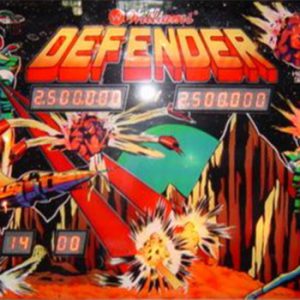 Defender is an arcade video game developed and released by Williams Electronics in 1980. A shooting game featuring two-dimensional (2D) graphics, the game is set on a fictional planet where the player must defeat waves of invading aliens while protecting astronauts. Development was led by Eugene Jarvis, a pinball programmer at Williams; Defender was Jarvis’ first video game project, and drew inspiration from Space Invaders and Asteroids. Defender is a two-dimensional side-scrolling shooting game set on the surface of an unnamed planet. The player controls a space ship as it navigates the terrain, flying either to the left or right. A joystick controls the ship’s elevation, and five buttons control its horizontal direction and weapons. The object is to destroy alien invaders, while protecting astronauts on the landscape from abduction. Humans that are successfully abducted return as mutants that attack the ship. Defeating the aliens allows the player to progress to the next level. Failing to protect the astronauts, however, causes the planet to explode and the level to become populated with mutants. Surviving the waves of mutants results in the restoration of the planet. Players are allotted three chances (lives) to progress through the game and are able to earn more by reaching certain scoring benchmarks. A life is lost if the ship comes into contact with an enemy or its projectiles. After exhausting all lives, the game ends. Defender is an arcade video game developed and released by Williams Electronics in 1980. A shooting game featuring two-dimensional (2D) graphics, the game is set on a fictional planet where the player must defeat waves of invading aliens while protecting astronauts. Development was led by Eugene Jarvis, a pinball programmer at Williams; Defender was Jarvis’ first video game project and drew inspiration from Space Invaders and Asteroids. Defender was one of the most important titles of the Golden Age of Arcade Games, selling over 55,000 units to become the company’s best selling game and one of the highest-grossing arcade games ever. Praise among critics focused on the game’s audio-visuals and gameplay. It is frequently listed as one of Jarvis’ best contributions to the video game industry as well as one of the most difficult video games. Defender was ported to numerous platforms, inspired the development of other games, and was followed by sequels and many imitations. Defender is a two-dimensional side-scrolling shooting game set on the surface of an unnamed planet. The player controls a space ship as it navigates the terrain, flying either to the left or right. A joystick controls the ship’s elevation, and five buttons control its horizontal direction and weapons. The object is to destroy alien invaders while protecting astronauts on the landscape from abduction. Humans who are successfully abducted return as mutants that attack the ship. Defeating the aliens allows the player to progress to the next level. Failing to protect the astronauts, however, causes the planet to explode and the level to become populated with mutants. Surviving the waves of mutants results in the restoration of the planet. Players are allotted three chances (lives) to progress through the game and are able to earn more by reaching certain scoring benchmarks. A life is lost if the ship comes into contact with an enemy or its projectiles. After exhausting all lives, the game end.
Defender is an arcade video game developed and released by Williams Electronics in 1980. A shooting game featuring two-dimensional (2D) graphics, the game is set on a fictional planet where the player must defeat waves of invading aliens while protecting astronauts. Development was led by Eugene Jarvis, a pinball programmer at Williams; Defender was Jarvis’ first video game project, and drew inspiration from Space Invaders and Asteroids. Defender is a two-dimensional side-scrolling shooting game set on the surface of an unnamed planet. The player controls a space ship as it navigates the terrain, flying either to the left or right. A joystick controls the ship’s elevation, and five buttons control its horizontal direction and weapons. The object is to destroy alien invaders, while protecting astronauts on the landscape from abduction. Humans that are successfully abducted return as mutants that attack the ship. Defeating the aliens allows the player to progress to the next level. Failing to protect the astronauts, however, causes the planet to explode and the level to become populated with mutants. Surviving the waves of mutants results in the restoration of the planet. Players are allotted three chances (lives) to progress through the game and are able to earn more by reaching certain scoring benchmarks. A life is lost if the ship comes into contact with an enemy or its projectiles. After exhausting all lives, the game ends. Defender is an arcade video game developed and released by Williams Electronics in 1980. A shooting game featuring two-dimensional (2D) graphics, the game is set on a fictional planet where the player must defeat waves of invading aliens while protecting astronauts. Development was led by Eugene Jarvis, a pinball programmer at Williams; Defender was Jarvis’ first video game project and drew inspiration from Space Invaders and Asteroids. Defender was one of the most important titles of the Golden Age of Arcade Games, selling over 55,000 units to become the company’s best selling game and one of the highest-grossing arcade games ever. Praise among critics focused on the game’s audio-visuals and gameplay. It is frequently listed as one of Jarvis’ best contributions to the video game industry as well as one of the most difficult video games. Defender was ported to numerous platforms, inspired the development of other games, and was followed by sequels and many imitations. Defender is a two-dimensional side-scrolling shooting game set on the surface of an unnamed planet. The player controls a space ship as it navigates the terrain, flying either to the left or right. A joystick controls the ship’s elevation, and five buttons control its horizontal direction and weapons. The object is to destroy alien invaders while protecting astronauts on the landscape from abduction. Humans who are successfully abducted return as mutants that attack the ship. Defeating the aliens allows the player to progress to the next level. Failing to protect the astronauts, however, causes the planet to explode and the level to become populated with mutants. Surviving the waves of mutants results in the restoration of the planet. Players are allotted three chances (lives) to progress through the game and are able to earn more by reaching certain scoring benchmarks. A life is lost if the ship comes into contact with an enemy or its projectiles. After exhausting all lives, the game end. -
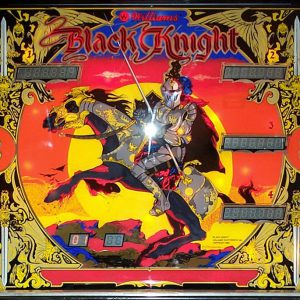 This game is another breakthru game by Williams. 13,075 units were made. Steve Ritchie designed the game and Tony Ramunni did the art package. Larry Demar programmed the game. Black Knight invented the “magna save” feature which is activated by the second flipper buttons on the side of the cabinet. When active, timing is critical. By activating this feature, the ball, which was about to drain down the side drains, is magically transported to the ball guide lane back to the flipper for continued play. This game also incorporated the “bonus ball” feature if more than one player was playing the game. The person with the highest score is awarded at the end of the game with a bonus round, which is timed to try and pop a game. Finally, this game is the first game to have a two-level playfield. Steve Ritchie, the designer, used his voice as the Black Knight.
This game is another breakthru game by Williams. 13,075 units were made. Steve Ritchie designed the game and Tony Ramunni did the art package. Larry Demar programmed the game. Black Knight invented the “magna save” feature which is activated by the second flipper buttons on the side of the cabinet. When active, timing is critical. By activating this feature, the ball, which was about to drain down the side drains, is magically transported to the ball guide lane back to the flipper for continued play. This game also incorporated the “bonus ball” feature if more than one player was playing the game. The person with the highest score is awarded at the end of the game with a bonus round, which is timed to try and pop a game. Finally, this game is the first game to have a two-level playfield. Steve Ritchie, the designer, used his voice as the Black Knight. -
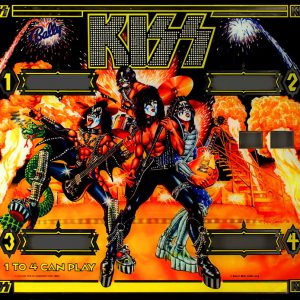 This very collectible game of the ‘70s was another in a series of celebrity-themed tie-in games Bally found license to produce. 17,000 units were made, a sizable number for the day. A prototype speaking version of this game was made ahead of its time but failed to be marketed. The object of the game is to spell out the name KISS. If you complete four times, a super bonus is awarded. Do it again and a colossal bonus is awarded. A third time awards a replay and a ton of points…which can be doubled if the 2x value drop targets are completed. The A, B, C, and D targets also can award extra balls and specials. The left drop targets award the KISS line when completed. All in all, an exciting game with great graphics but no speech. Talking pinballs finally made the scene with the release of Gorgar (in the museum). Replays are also awarded by score or matching. Matching is the process by which the last two numbers of your score match the generated number produced by the game.
This very collectible game of the ‘70s was another in a series of celebrity-themed tie-in games Bally found license to produce. 17,000 units were made, a sizable number for the day. A prototype speaking version of this game was made ahead of its time but failed to be marketed. The object of the game is to spell out the name KISS. If you complete four times, a super bonus is awarded. Do it again and a colossal bonus is awarded. A third time awards a replay and a ton of points…which can be doubled if the 2x value drop targets are completed. The A, B, C, and D targets also can award extra balls and specials. The left drop targets award the KISS line when completed. All in all, an exciting game with great graphics but no speech. Talking pinballs finally made the scene with the release of Gorgar (in the museum). Replays are also awarded by score or matching. Matching is the process by which the last two numbers of your score match the generated number produced by the game. -
 This wide-body solid-state game was a high-production model with 6,800 units produced. The artwork was Gordon Morison’s creation with Ed Krynski penning the playfield. This pre-vocal machine is jam-packed with features. A mini playfield in the upper left consists of drop targets which, when completed correctly, light extra ball and special targets on the main playfield. Hitting a, b, c, and d on the top rollovers lights an extra ball feature on the mini playfield. Hitting the yellow star drop targets advances the multiplier bonus up to a 5x level. Interesting side drain configurations as well as the potential to score the kick-out hole playfield bonus prior to draining a ball is interesting. Five flippers grace the game. All in all, a great package and interesting flow for an early wide-body creation.
This wide-body solid-state game was a high-production model with 6,800 units produced. The artwork was Gordon Morison’s creation with Ed Krynski penning the playfield. This pre-vocal machine is jam-packed with features. A mini playfield in the upper left consists of drop targets which, when completed correctly, light extra ball and special targets on the main playfield. Hitting a, b, c, and d on the top rollovers lights an extra ball feature on the mini playfield. Hitting the yellow star drop targets advances the multiplier bonus up to a 5x level. Interesting side drain configurations as well as the potential to score the kick-out hole playfield bonus prior to draining a ball is interesting. Five flippers grace the game. All in all, a great package and interesting flow for an early wide-body creation. -
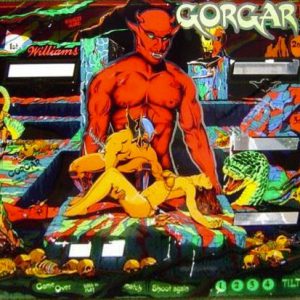 This game was a breakthru game. It is the first-ever talking pinball machine. Games of this era had synthesized sound, but this game spoke. The speech wasn’t very clear or very wordy, as memory chips of this era couldn’t hold too much information compared to today’s games, but it was a sensation for Williams. The production run for the game was 14,000 units. It was designed by Barry Oursler with art by Constantino Mitchell. The top three rollover lanes would, if completed give up two, then three times bonus. The snake pit in the upper-left playfield has a magnet under it, which captures the ball for bonuses and Gorgar’s chance to use his seven-word vocabulary. Spelling out the word “Gorgar” makes the monster say his name and increases bonus values. This game also incorporates the background noise made famous in the Williams game Flash (in the museum). This time the background sound is of a heartbeat. It gets faster and faster as you advance.
This game was a breakthru game. It is the first-ever talking pinball machine. Games of this era had synthesized sound, but this game spoke. The speech wasn’t very clear or very wordy, as memory chips of this era couldn’t hold too much information compared to today’s games, but it was a sensation for Williams. The production run for the game was 14,000 units. It was designed by Barry Oursler with art by Constantino Mitchell. The top three rollover lanes would, if completed give up two, then three times bonus. The snake pit in the upper-left playfield has a magnet under it, which captures the ball for bonuses and Gorgar’s chance to use his seven-word vocabulary. Spelling out the word “Gorgar” makes the monster say his name and increases bonus values. This game also incorporates the background noise made famous in the Williams game Flash (in the museum). This time the background sound is of a heartbeat. It gets faster and faster as you advance. -
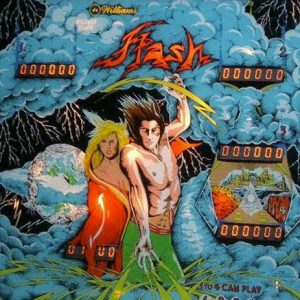 This game was a breakthru game for Williams in January. It was designed by Steve Ritchie with art by Constantino Mitchell. Flash was the first game to have a continous background sound during play and the crescendo of the sound sped up as you advanced thru the game. This is also the first game to use “flash lamps”, which are higher voltage lights that really make a presence when they light. The first thing you notice on this non-speaking game is, when you shoot the ball from the plunger, the ball travels diagonally across the playfield and ends at the top of the playfield from left to right. The top rollovers consist of 4 numbers. If you hit 1-3, you get a double bonus; all four made gives a triple bonus. 19,505 games were made, a big production run. This game also has the advance bonus eject hole, drop targets, and, of course, the bright “flash” show when activated. This game was a main staple in arcades of the ’80s.
This game was a breakthru game for Williams in January. It was designed by Steve Ritchie with art by Constantino Mitchell. Flash was the first game to have a continous background sound during play and the crescendo of the sound sped up as you advanced thru the game. This is also the first game to use “flash lamps”, which are higher voltage lights that really make a presence when they light. The first thing you notice on this non-speaking game is, when you shoot the ball from the plunger, the ball travels diagonally across the playfield and ends at the top of the playfield from left to right. The top rollovers consist of 4 numbers. If you hit 1-3, you get a double bonus; all four made gives a triple bonus. 19,505 games were made, a big production run. This game also has the advance bonus eject hole, drop targets, and, of course, the bright “flash” show when activated. This game was a main staple in arcades of the ’80s. -
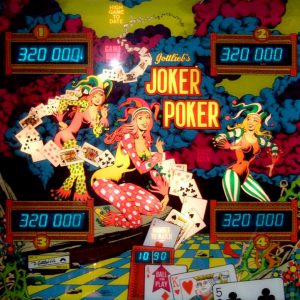 Gottlieb Joker Poker pinball. An interesting design, and only made in a 4 player version (no 2 player, unusual for Gottlieb pinball). One bank of five ace drop targets, one bank of four king drop targets, one bank of three jack targets, one bank of two queen drop targets, and a single ten drop target. Pretty cool pinball design really. Two pop bumpers, one slingshot, two 3″ flippers. They made 820 Gottlieb EM Joker Poker pinballs.
Gottlieb Joker Poker pinball. An interesting design, and only made in a 4 player version (no 2 player, unusual for Gottlieb pinball). One bank of five ace drop targets, one bank of four king drop targets, one bank of three jack targets, one bank of two queen drop targets, and a single ten drop target. Pretty cool pinball design really. Two pop bumpers, one slingshot, two 3″ flippers. They made 820 Gottlieb EM Joker Poker pinballs. -
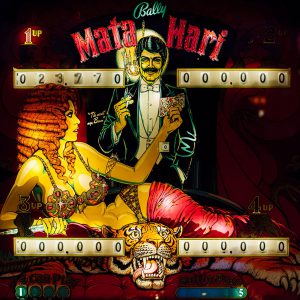 Mata Hari was released in April of the year and designed by Jim Patla with artwork accolades going to Dave Christiansen. 16,200 of these machines were produced in the new solid-state format (as seen in the museum) as well as bunch of electromechanical machines (170, to be exact) to keep the non-computer savvy operators happy and buying machines they knew how to fix. This machine before you is one of the finest examples of this ultra-rare mechanical format. Like the solid-state version, the center kickout hole scores 3,000 points and each successful shot in the hole advances the bonus multiplier. The A and B skill shots advance the horizontal sequence of increasing values in the center of the playfield. 50,000 points are awarded when a battery of drop targets is hit. If both batteries are knocked down, the drop targets reset and hitting all again awards the replay. Score is another replay option.
Mata Hari was released in April of the year and designed by Jim Patla with artwork accolades going to Dave Christiansen. 16,200 of these machines were produced in the new solid-state format (as seen in the museum) as well as bunch of electromechanical machines (170, to be exact) to keep the non-computer savvy operators happy and buying machines they knew how to fix. This machine before you is one of the finest examples of this ultra-rare mechanical format. Like the solid-state version, the center kickout hole scores 3,000 points and each successful shot in the hole advances the bonus multiplier. The A and B skill shots advance the horizontal sequence of increasing values in the center of the playfield. 50,000 points are awarded when a battery of drop targets is hit. If both batteries are knocked down, the drop targets reset and hitting all again awards the replay. Score is another replay option. -
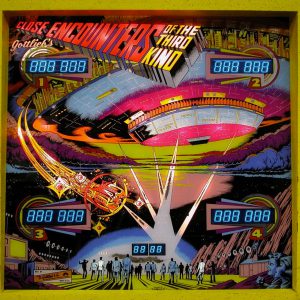 September was the month for the introduction of this game. Both solid-state and mechanical versions were produced (9,950 versus 550 units, respectively). Ed Krynski designed the machine with art by Gordon Morison. A roto-target was incorporated into the upper right of the game, a Gottlieb exclusive. Hitting the A-B-C rollovers lights up the extra ball target and increases the value of the roto-targets as well as the drop target values. Knocking down all the drop targets increases the bonus multiplier value. The second time this feat is completed lights the special roto-target value. This game also features a bonus advance bank which increases to 20,000 points and a two to five times bonus multiplier feature. Score is the other way to win games.
September was the month for the introduction of this game. Both solid-state and mechanical versions were produced (9,950 versus 550 units, respectively). Ed Krynski designed the machine with art by Gordon Morison. A roto-target was incorporated into the upper right of the game, a Gottlieb exclusive. Hitting the A-B-C rollovers lights up the extra ball target and increases the value of the roto-targets as well as the drop target values. Knocking down all the drop targets increases the bonus multiplier value. The second time this feat is completed lights the special roto-target value. This game also features a bonus advance bank which increases to 20,000 points and a two to five times bonus multiplier feature. Score is the other way to win games. -
Gottlieb released the game “Sinbad” in both solid-state and electromechanical formats in June of the year. Designed by Ed Krynski with art by Gordon Morison, there were 12,000 S.S. games and 950 E.M. games made. This machine is the rare two-player version of the game, of which 730 were made. Drop targets are the main theme of this game. Knocking down the single white drop target awards a 2x bonus and lights the white rollover. The three yellow drops were next. If hit, 3x bonus is awarded when the ball drains and the 5,000 rollover lights at the top of the playfield. The four purple drops were next. Making these would award 4x bonus and light the extra ball rollover. Finally, the five red drops; when hit would award 5x bonus (the maximum bonus that could register is 15,000 points times the bonus) as well as light the special rollover. Four flippers allowed for interesting play, also.